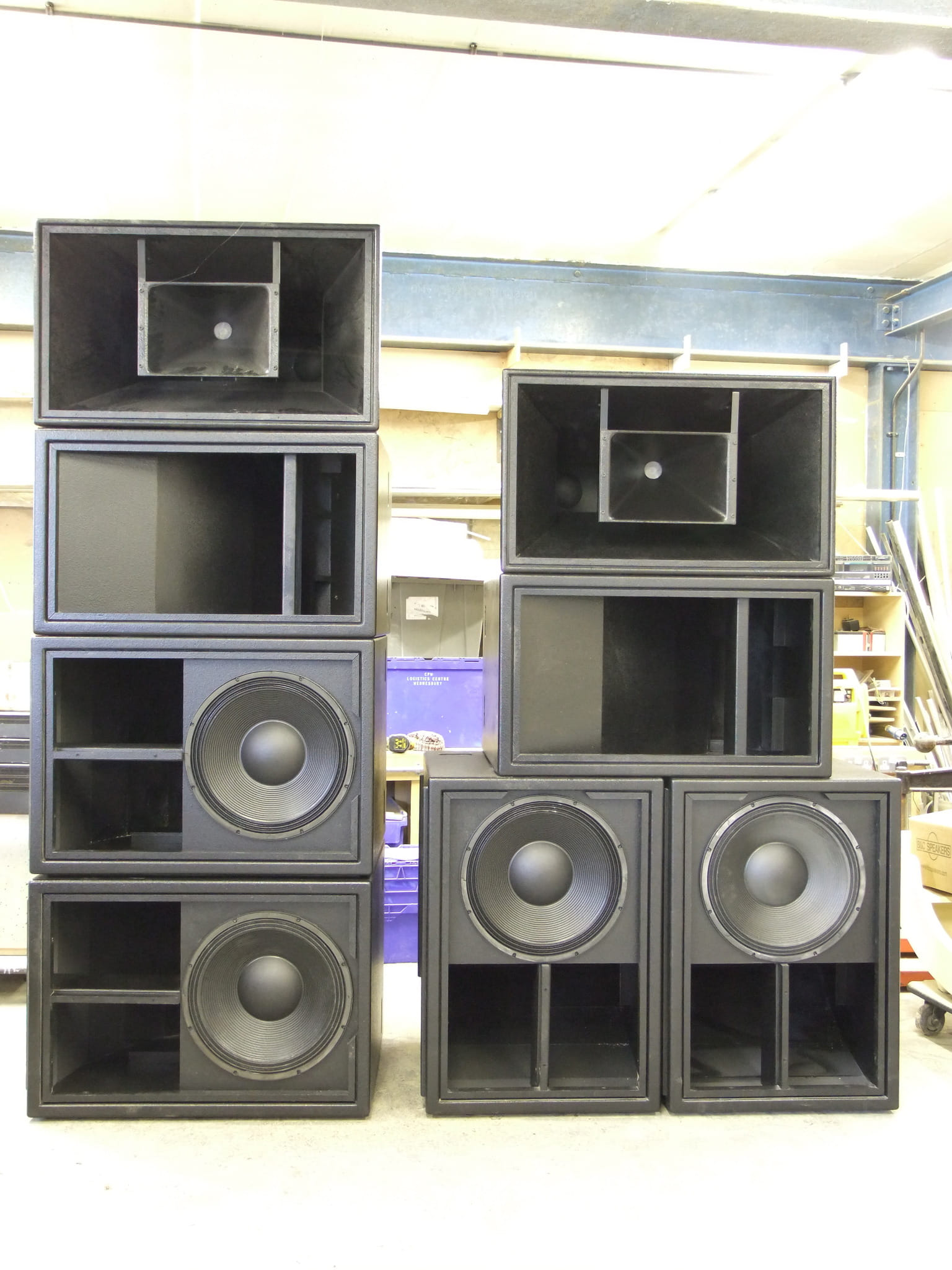- Posts: 273
- Thank you received: 3
Unity Horns /Why they work / Potential Patent Challenges /
- Tony Wilkes
-

- Offline
- Elite Member
-

As Aunty Cilla has stated if anyone has evidence to the contrary please quote the source. Don't just argue for arguments sake.
Tony
Please Log in or Create an account to join the conversation.
- mykey-
-

- Offline
- Platinum Member
-

- Posts: 410
- Thank you received: 2
Bob! what are the house prices like in the twilight zone?
Please Log in or Create an account to join the conversation.
- mykey-
-

- Offline
- Platinum Member
-

- Posts: 410
- Thank you received: 2
Please Log in or Create an account to join the conversation.
- bjm362
-
 Topic Author
Topic Author
- Offline
- Premium Member
-

- Posts: 142
- Thank you received: 5
Actually there are mathmatic formulas for compression ratios in horns. Its part of a method of improving the acoustic coupling. Remember a speaker is an acoustic transducer. Its function is to change electric signal into auditory waves. The better it is couple to the air the greater the performance.mykey- wrote: ....another thing! not read much into these, but, I always look at things in a super practical way.....the way these drivers are loaded (firing through a small hole that's way smaller than the cone it's self) completely goes against the grain of things. How can you expect all the sound waves from the cone to get out in a ORDERLY fashion? the sound is going to be bouncing back and forth like a cosha Jews head in prayer
Accordinding to Wikipedia not all gasses respond the same to different frequencies. I The cause is different than I thought, but the efect remains.Tony Wilkes wrote: For all intents and purposes the speed of sound through air is a constant at ALL audible frequencies. What tiny tiny differences that do exist are of absolutely no relevance.
As Aunty Cilla has stated if anyone has evidence to the contrary please quote the source. Don't just argue for arguments sake.
Tony
Since this anomilie is included in the very definition of the speed of sound I hope you find it satisfactory!
BTW, I wasn't arguing for arguements sake, i was trying to express a viewpoint and look at others expressed.
From Wikipedia:
Effect of frequency and gas composition
The medium in which a sound wave is travelling does not always respond adiabatically, and as a result the speed of sound can vary with frequency.[13]
The limitations of the concept of speed of sound due to extreme attenuation are also of concern. The attenuation which exists at sea level for high frequencies applies to successively lower frequencies as atmospheric pressure decreases, or as the mean free path increases. For this reason, the concept of speed of sound (except for frequencies approaching zero) progressively loses its range of applicability at high altitudes.:[5] The standard equations for the speed of sound apply with reasonable accuracy only to situations in which the wavelength of the soundwave is considerably longer than the mean free path of molecules in a gas.
The molecular composition of the gas contributes both as the mass (M) of the molecules, and their heat capacities, and so both have an influence on speed of sound. In general, at the same molecular mass, monatomic gases have slightly higher sound speeds (over 9% higher) because they have a higher γ (5/3 = 1.66...) than diatomics do (7/5 = 1.4). Thus, at the same molecular mass, the sound speed of a monatomic gas goes up by a factor of
= 1.091...
This gives the 9 % difference, and would be a typical ratio for sound speeds at room temperature in helium vs. deuterium, each with a molecular weight of 4. Sound travels faster in helium than deuterium because adiabatic compression heats helium more, since the helium molecules can store heat energy from compression only in translation, but not rotation. Thus helium molecules (monatomic molecules) travel faster in a sound wave and transmit sound faster. (Sound generally travels at about 70% of the mean molecular speed in gases).
Note that in this example we have assumed that temperature is low enough that heat capacities are not influenced by molecular vibration (see heat capacity). However, vibrational modes simply cause gammas which decrease toward 1, since vibration modes in a polyatomic gas gives the gas additional ways to store heat which do not affect temperature, and thus do not affect molecular velocity and sound velocity. Thus, the effect of higher temperatures and vibrational heat capacity acts to increase the difference between sound speed in monatomic vs. polyatomic molecules, with the speed remaining greater in monatomics.
Please Log in or Create an account to join the conversation.
- bjm362
-
 Topic Author
Topic Author
- Offline
- Premium Member
-

- Posts: 142
- Thank you received: 5
Excellent point Tony ! Sorry I failed to account for that in my analogy. In fact as tired as I am right now I don't seem to be able to come up with a good analogy that also accounts for throw.Tony.A.S.S. wrote: Regarding the last part of Bobby Mosley's piece, it should also be remembered that what we term as throw, has a part to play in this. The Bugle, being a horn structured instrument will project further due to the horn and the way the note is started from source. Whereas the violin is only able to radiate sound around its own sound box, and the notes have a much more gentle start to life.
P.S. I have seen it debated as to whether or not throw exists. Like I said earlier speaker building is still as much art as it is science! I just thought unity horns were interesting despite my viewpoint that the patent was smoke and mirrors !
Please Log in or Create an account to join the conversation.
- deadbeat
-

- Offline
- Platinum Member
-

In a non-dispersive medium sound speed is independent of sound frequency, so the speeds of energy transport and sound propagation are the same. For audible sounds air is a non-dispersive medium. But air does contain a small amount of CO2 which is a dispersive medium, and it introduces dispersion to air at ultrasonic frequencies (> 28 kHz).[3]
In a dispersive medium sound speed is a function of sound frequency, through the dispersion relation. The spatial and temporal distribution of a propagating disturbance will continually change. Each frequency component propagates at its own phase velocity, while the energy of the disturbance propagates at the group velocity. The same phenomenon occurs with light waves; see optical dispersion for a description.
It's pretty intuitive. If there was enough dispersion in air for there to be significant phase differences at LF, we would be hearing shit. Nobody disagreed that it was different in other gases
You said:
The comment about the difference being miniscule is correct! However they are NOT impercievable! The Human ear IS accurate enough to hear them and the brain both processes and filters them.
Evidence?
I don't think this is correct.
Beranek\'s law
\'bits of ply round a driver\'
Please Log in or Create an account to join the conversation.
- tony.a.s.s.
-

- Offline
- Moderator
-

- Posts: 1344
- Thank you received: 12
Peace and goodwill to all speaker builders
Please Log in or Create an account to join the conversation.
- bee
-

- Offline
- Platinum Member
-

- Posts: 2090
- Thank you received: 34
Please Log in or Create an account to join the conversation.
- Tony Wilkes
-

- Offline
- Elite Member
-

- Posts: 273
- Thank you received: 3
If we all suddenly went blind does that mean light ceases to exist? I think its the same with ears, we have them to hear the noise, if noise did not exist no need for the ears.
Tony
Please Log in or Create an account to join the conversation.
- tony.a.s.s.
-

- Offline
- Moderator
-

- Posts: 1344
- Thank you received: 12
Peace and goodwill to all speaker builders
Please Log in or Create an account to join the conversation.